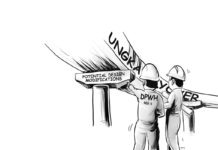BY IKE SEÑERES
THERE is a big difference between “comparative advantage” and “competitive advantage” and I hope that our economic policy makers would understand that difference.
I am sure that these two concepts are not the same and are not interchangeable, in the same way that “poverty alleviation” and “poverty reduction” are not the same, and are not interchangeable.
Sad to say up to know, I would hear many government officials talking about poverty as if “alleviation” and “reduction” are one and the same. Not that I am a stickler for accurate definitions, but I do believe that the proper understanding of terms is the first and step towards the formulation of correct policies, the same policies that become the basis for precise programs and projects.
As I understand it, “comparative advantage” and “competitive advantage” could actually complement each other and could work together, but first we need to understand the difference between the two.
In theory, one country can have a “comparative advantage” if it could produce certain goods at lower costs compared to the other countries that are also producing the same goods.
Also in theory, one country could have a “competitive advantage” if it develops an attribute or a combination of attributes that would allow it to outperform the other countries that are competing in the same field.
These unique attributes could be in the form of natural resources, cheap electricity, breakthrough technologies or skilled manpower. These theories are also applicable to companies as these are applicable to countries.
Looking at the basic definitions, it is easy to understand that having a “competitive advantage” could actually lead to having a “comparative advantage”, if we play the game right, because our combination of attributes could actually enable us to produce goods at lower costs compared to our competitors.
What is even better is if we could produce more of these goods at relatively higher quality standards than our competitors, then we could certainly outperform them in the product categories where we could become the strongest players. These ideas are applicable not only to international trade in general, but also to the forthcoming ASEAN Economic Community (AEC) in particular.
It is already a foregone conclusion that we could hardly have a “competitive advantage” in certain product categories that would require cheap electricity and breakthrough technologies, the kind that would require billions of dollars to develop.
However, it is also very clear that we could still have a “competitive advantage” in other product categories that would only require certain types of natural resources and skilled manpower.
The name of the game therefore is to choose the right product categories where we already have a “competitive advantage” so that in turn we could have the right “comparative advantage” when we bring out these goods to the world markets.
Not that I have given up the fight before it has actually started, because I actually believe that there are still many product categories wherein cheap electricity will not even be an issue if only we could harness cheaper sources of electricity such as biodiesel, solar and gasifier.
There are also many other product categories wherein our unique blends of skilled manpower could give us an edge, such as computer animations and digital arts. All of these considered however, it would seem that our best choice is to identify the product categories where we could become the strongest player, because of our unique blends of natural resources, our God given assets that could turn out to be our most precious attributes.
Believe it or not, I have long been looking for the “Holy Grail”, the proverbial product categories that would give us the “competitive advantage” in international trade, and it seems that I have now found it, albeit by accident.
I was doing some research about mangroves when I came across the information that the Philippines has one of the longest coastlines in the world. Researching further, I found out that according to the World Factbook, the Philippines has the fifth longest coastline in the world, after Canada, Indonesia, Greenland and Russia.
In terms of tropical coastline products therefore, Indonesia is our only other competitor, and they could even become our ally within the context of the AEC. For sure, we have certain tropical coastline products that Indonesia does not have.
Having one of the longest tropical coastlines in the world gives us the “competitive advantage” in making products that are saline tolerant or saline dependent. That is just one side of it, because it also gives us the “competitive advantage” of making products from a natural marine environment.
In theory, the easement area from the seashore going inland is supposed to be about fifteen meters, but many areas have already been claimed by private owners. Even with that however, there are still many large areas that are considered as public lands. This is not really a big issue, because even the private lands could still be tapped for productive use. What is even bigger is the water area from the seashore up to the limits of the so called “municipal waters”.
Believe it or not, the lowly mangrove could be the key to the goal of having a global “competitive advantage” by way of a fully productive coastal economy. Where there are mangroves, the planktons would come back. Where there are planktons, the fish would come back. Not only the fish would come back, but also the other high value marine life such as clams, crabs and shrimps.
There could also be an added bonus, and that is the return of many schools of fish inward into the coastal areas, from where they are now beyond the municipal waters. Imagine how good that would be for the many marginal fishermen who need not go far to catch fish. The mangrove itself is also a source of high quality firewood if these are properly cut without destroying the trees.
Believe it or not, there are many other products that are saline tolerant or saline dependent, among which are the lowly talisay trees and some saline rice varieties. To my surprise, I found out that the fruits of the talisay trees are called sea almonds, a product that could possibly compete with macadamia nuts. The saline rice varieties are an interesting lot, and I was told that dinorado is one of them.
The advantage of these saline rice varieties is that they need not depend on the fresh water irrigation that costs so much to maintain. With a simple pump, sea water could be transferred into the rice fields that are near the coastal areas.
I am sure that if we look further and do more research, we could find many more crops that could help us build a globally competitive coastal economy. And yes, we are not even talking about seaweeds and fish cages yet! (Email bantaygobyerno- subscribe@yahoogroups.com or text +639369198429)/PN



